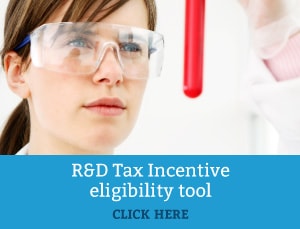Do Your R&D Activities Have a Dominant Purpose?
February 26th, 2016 Undeniably, the rules and regulations surrounding the Research and Development (R&D) tax incentive may be bewildering for some. This is particularly the case when distinguishing the eligible R&D activities. To clarify, both ‘core’ and ‘supporting’ R&D activities can be claimed – however, activities must show that they are undertaken for the dominant purpose of supporting R&D activities or generating new knowledge, rather than a commercial or other purpose. With the April 30 tax deadline looming, the importance of correct compliance is mounting. Therefore, in order to illustrate the meaning of ‘dominant purpose’, the Administrative Appeals Tribunal (AAT) decision in the case of the JLSP and Innovation Australia [2016] AATA 23 will be used as an example.
Undeniably, the rules and regulations surrounding the Research and Development (R&D) tax incentive may be bewildering for some. This is particularly the case when distinguishing the eligible R&D activities. To clarify, both ‘core’ and ‘supporting’ R&D activities can be claimed – however, activities must show that they are undertaken for the dominant purpose of supporting R&D activities or generating new knowledge, rather than a commercial or other purpose. With the April 30 tax deadline looming, the importance of correct compliance is mounting. Therefore, in order to illustrate the meaning of ‘dominant purpose’, the Administrative Appeals Tribunal (AAT) decision in the case of the JLSP and Innovation Australia [2016] AATA 23 will be used as an example.
Recently, the case of JLSP and Innovation Australia [2016] AATA 23 principally dealt with whether the core R&D activities of a claimant company, which was under a contractual agreement with another company, were conducted for the purpose of generating new knowledge. The result was that the claimant company’s core activities were not to generate new knowledge; but rather, the primary purpose of the activities was to fulfil obligations in accordance to the commercial agreement they had entered into with another company. To that end, the AAT concluded that “[…] the purpose of generating new knowledge does not have to be the purpose that outweighs all others. Instead, I consider that the purpose of generating new knowledge must be more than an insubstantial purpose […] even if at the same time other substantial purposes also exist. ”
Thus, as the JLSP and Innovation Australia case validates, companies must be capable of demonstrating the purpose of each core R&D activity. Ultimately, the R&D activity must be more than an ‘insubstantial purpose’, yet it doesn’t need to be the purpose that dwarfs all others. In fact, in some cases R&D can be a business as usual activity. However, in these instances, the company must illustrate that a substantial purpose for each core R&D activity is to produce new knowledge. Lastly, if the R&D is conducted for an associated foreign company then proper contracts must be established.
Ultimately, with the increased compliance focus by AusIndustry and the ATO, now is a good time to discuss your claim and compliance concerns with a registered R&D Tax Specialist. Swanson Reed is a specialist R&D Tax Consultant firm that will be able to help you with any of your concerns. Contact us today if you would like to learn more about the R&D Tax Incentive.
Categories
- ATO Guidance and Materials
- AusIndustry Guidance and Materials
- Case Law
- Federal Budget 2021
- Federal Budget 2022
- Federal Budget 2024
- For Accountants
- General Information
- Government Policy and Treasury
- Industry Specific Issues
- Interpretative Decisions
- Legislation and Parliamentary Matters
- R&D Tax Credit
- R&D Tax Funding Strategies
- R&D Tax Loans
- Recent News
- Tax Determinations
Archives
- July 2024
- June 2024
- May 2024
- April 2024
- March 2024
- February 2024
- January 2024
- December 2023
- November 2023
- October 2023
- September 2023
- August 2023
- July 2023
- June 2023
- May 2023
- April 2023
- March 2023
- February 2023
- January 2023
- December 2022
- November 2022
- October 2022
- September 2022
- August 2022
- July 2022
- June 2022
- May 2022
- April 2022
- March 2022
- February 2022
- January 2022
- December 2021
- November 2021
- October 2021
- September 2021
- August 2021
- July 2021
- June 2021
- May 2021
- April 2021
- March 2021
- February 2021
- January 2021
- December 2020
- November 2020
- October 2020
- September 2020
- August 2020
- July 2020
- June 2020
- May 2020
- April 2020
- March 2020
- February 2020
- January 2020
- December 2019
- November 2019
- October 2019
- September 2019
- August 2019
- July 2019
- June 2019
- May 2019
- April 2019
- March 2019
- February 2019
- January 2019
- December 2018
- November 2018
- September 2018
- July 2018
- June 2018
- May 2018
- April 2018
- March 2018
- February 2018
- January 2018
- December 2017
- November 2017
- September 2017
- August 2017
- July 2017
- June 2017
- May 2017
- April 2017
- March 2017
- February 2017
- January 2017
- December 2016
- November 2016
- October 2016
- September 2016
- August 2016
- July 2016
- June 2016
- May 2016
- April 2016
- March 2016
- February 2016
- January 2016
- December 2015
- November 2015
- October 2015
- September 2015
- August 2015
- July 2015
- June 2015
- May 2015
- April 2015
- March 2015
- February 2015
- January 2015
- November 2014
- October 2014
- September 2014
- August 2014
- July 2014
- June 2014
- May 2014
- April 2014
- March 2014
- February 2014
- January 2014
- December 2013
- November 2013
- October 2013
- September 2013
- May 2013
- April 2013
- March 2013
- September 2012
- August 2012
- June 2012


 Free Call: 1800 792 676
Free Call: 1800 792 676





 News & Research
News & Research



